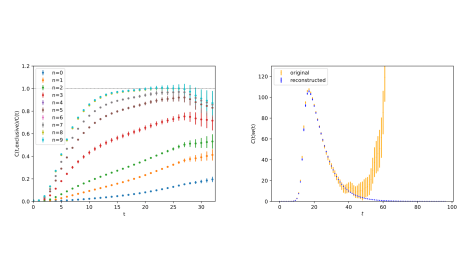ALCF projects cover many scientific disciplines, ranging from biology and physics to materials science and energy technologies. Filter ongoing and past projects by allocation program, scientific domain, and year.
Hadronic Contributions to the Muon G-2 from Lattice QCD
To resolve the difference between lattice and data-driven theory values, the project aims to compute the hadronic contributions at the sub-percent level, and ultimately to reach the expected precision of the experiment, at the one-to-two-permille level.
Exascale Models of Astrophysical Thermonuclear Explosions
This project builds upon the success of earlier INCITE awards that explored astrophysical thermonuclear explosions, as the researchers greatly expand their work to model thermonuclear flame propagation across the surface of a neutron star.
Carbon at Extremes: Discovery Science with Exascale Computers
The goals of this INCITE project are to design compressive pathways towards synthesis of elusive and long-sought post-diamond BC8 phase of carbon; uncover kinetics effects in phase transformations to BC8 phase from diamond and amorphous carbon in explicit, billion atom, double-shock simulations at micrometer and nanosecond time scales.
Flight-Scale Simulations of a Transport Aircraft in High-Lift Conditions
A current goal for the aircraft industry is to unambiguously demonstrate consistently accurate predictive computations of high-lift flows. If this objective can be realized, computations may facilitate a simulation-based approach to certification, thereby significantly reducing the cost of bringing a new aircraft to market while continuing to meet strict safety guidelines.
Heterogeneous Reaction Dynamics for Energy Storage and Hydrogen Production
This team will deploy new state-of-the-art machine learning (ML) methods to construct reliable and accurate force fields, trained on accurate quantum electronic structure (DFT) calculations and perform record-scale and -speed MD simulations of battery and catalytic interfaces.
Energy Exascale Earth System Model
This team set out to perform an unprecedented pair of decadal-scale climate simulations with an atmospheric grid spacing of 3.25 km.
Democratizing AI by Training Deployable Open-source Language Models
The team will use a sizeable INCITE allocation to explore efficient alternatives for transformer models for language modeling.
3D Imaging of Strong Interaction Nambu-Goldstone Bosons
This project will calculate the 3D structures of the pion and kaon, which are the Nambu-Goldstone bosons of the strong force that bind nuclei together, to advance our understanding of the strong interaction and confinement of quarks and gluons inside hadrons.
Foundation Models for Molecular Design for Energy Storage and Conversion
This project will scale up the training of foundation models to the largest available chemical libraries to advance the design of new electrolytes for energy storage and energy conversion applications.
Radiation-Dominated Black Hole Accretion
This project uses a new performance-portable version of the Athena++ astrophysical MHD code to perform the first calculations of radiation-dominated accretion on black holes using full transport methods and realistic opacities.
High Reynolds Number Hypersonic Transition Control via Porous Walls
This INCITE project seeks to create a direct numerical simulation (DNS) dataset capturing all the microscale processes involved in hypersonic boundary layer transition, so as to inform passive control techniques that reduce the drag and aerodynamic heating experienced in hypersonic flight.
Establishing Digital Twins for High Throughput Cellular Analysis in Whole Blood
This INCITE project seeks to address the major challenges facing cellular simulations to allow cancer researchers to quickly identify potentially deleterious mechano-phenotypes.
Foundation Models for Predictive Molecular Epidemiology
This project aims to build foundation models for large-scale genomic datasets for continuous monitoring and tracking of pathogens. It will thus increase biopreparedness and will benefit the community by making GenSLM models, data, and code available to a broad user base, who can fine-tune the foundation models for their own downstream predictive tasks.
Heteropolymer Design Harnessing New and Emerging Computing Technologies
This project aims to leverage both traditional supercomputers and quantum computers to make computational drug design more efficient.
Interface-resolved Simulations of Scalar Transport in Turbulent Bubbly Flows
This team of researchers will carry out direct numerical simulations to study and quantify turbulence kinetic energy and diffusive scalar fields in gravity-driven turbulent bubbly suspensions.
Exascale Simulations of Quantum Materials
This INCITE project helps to meet the challenges of reducing energy, realizing new technologies, and identifying the optimum materials for specific applications.
Online Machine Learning for Large-Scale Turbulent Simulations
This project will advance the current state of the art for online data analytics and machine learning applied to large-scale computational fluid dynamics (CFD) simulations to develop enhanced turbulence models for flows of interest to the aerospace, automotive, and renewable energy industries.
Exascale Cosmology: Lighting up the Dark Universe
This project will usher in a new era of cosmological simulations by fully exploiting the power of DOE’s exascale systems, providing scientific results that will be a critical input for ongoing and upcoming cosmological surveys.
Ab-initio Nuclear Structure and Nuclear Reactions
This project will advance our understanding of nuclear phenomena by targeting predictive capabilities regarding structure and reactions of nuclei, fundamental symmetries, and neutrino and electron interactions in nuclei.
QCD under Extreme Conditions
This work aims to determine the properties of strongly interacting matter under extreme conditions from numerical simulations of the early universe, experimental heavy ion collisions, and compact stars.



















